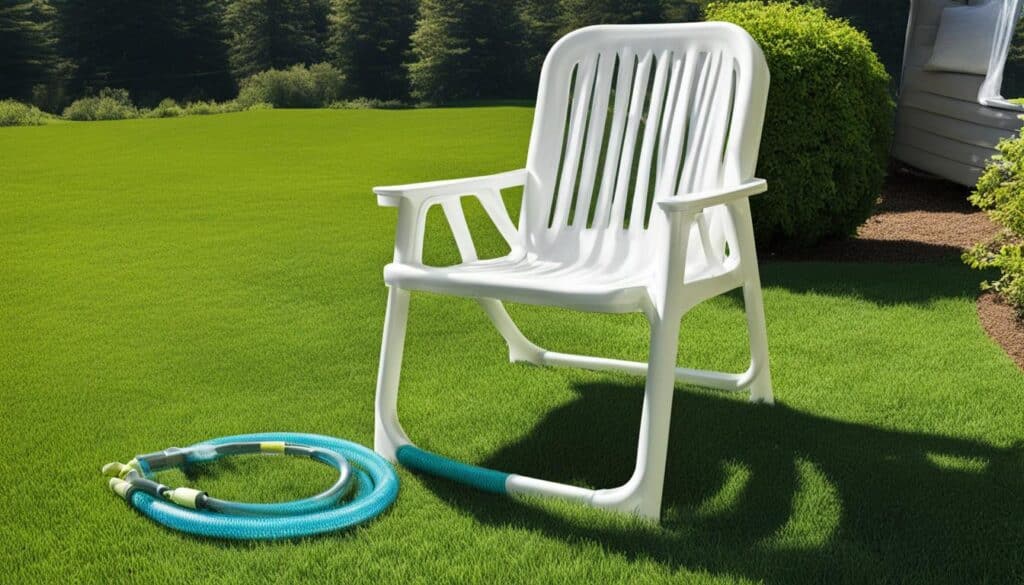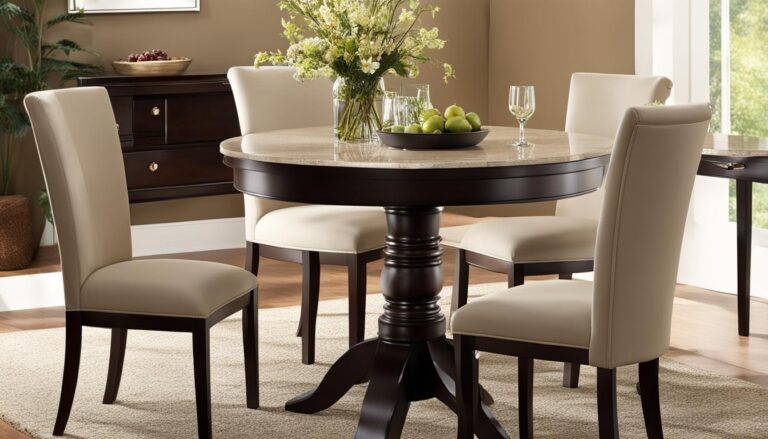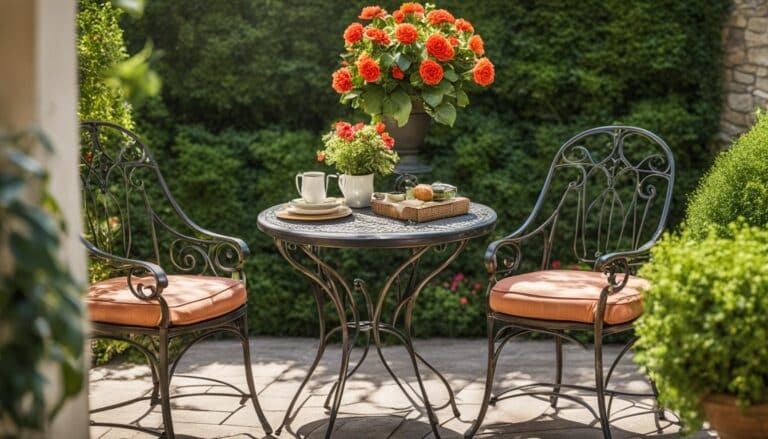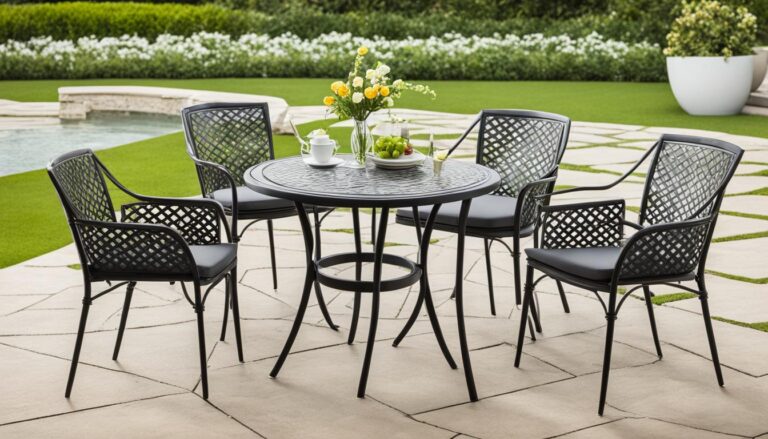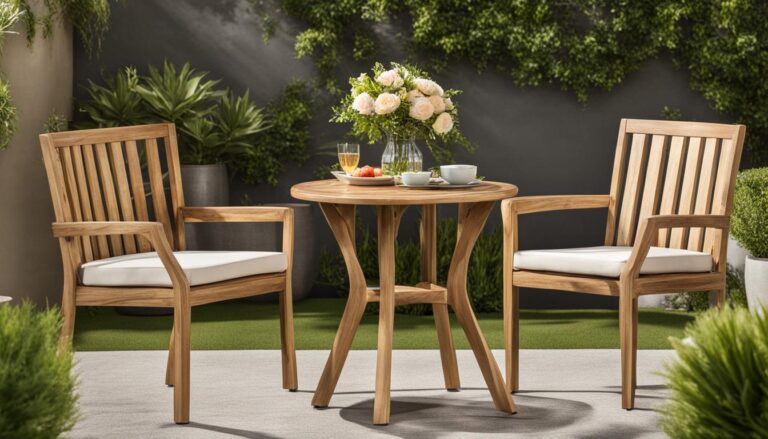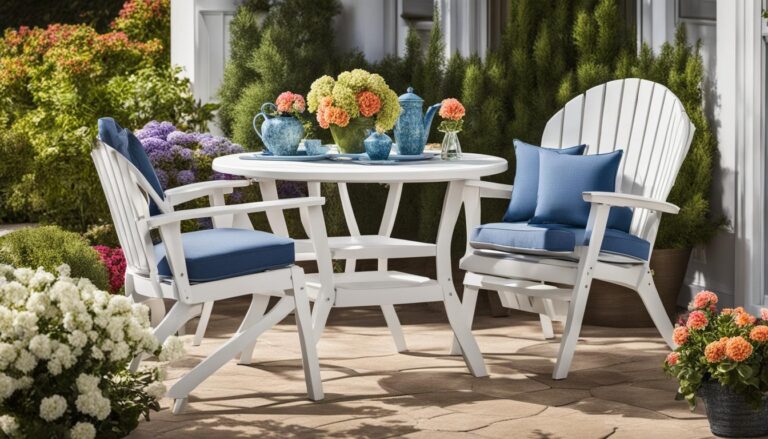Welcome to our guide on how to clean outdoor plastic furniture! If you own outdoor plastic furniture, you know how important it is to keep it clean and well-maintained. In this section, we will provide you with expert tips and essential cleaning techniques to help you restore the shine and extend the lifespan of your outdoor plastic furniture.
Key Takeaways:
- Regular cleaning is necessary to keep your outdoor plastic furniture looking pristine.
- Outdoor plastic furniture is lightweight, weather-resistant, and affordable.
- Essential cleaning tools include buckets, sponges, soft-bristled brushes, and microfiber towels.
- Effective cleaning products include baking soda, dishwashing liquid, all-purpose cleaner, and more.
- Follow our step-by-step guide to clean your outdoor plastic furniture effectively.
Advantages of Outdoor Plastic Furniture
When it comes to outdoor furniture, plastic is a fantastic option with many advantages. One of the standout benefits of outdoor plastic furniture is its lightweight nature. Unlike heavy wooden or metal furniture, plastic chairs and tables are easy to move around and rearrange to suit your outdoor space. Whether you want to create a cozy seating area or accommodate more guests for a gathering, lightweight plastic furniture gives you the flexibility to do so with ease.
Another advantage of outdoor plastic furniture is its weather-resistant properties. Plastic is designed to withstand various weather conditions, making it perfect for outdoor use. It won’t rot, rust, or fade when exposed to rain, sun, or snow, ensuring your furniture stays in good condition for years to come. This durability means you won’t have to worry about constantly replacing your outdoor furniture, saving you both time and money.
Additionally, outdoor plastic furniture often has environmental benefits. Many plastic furniture pieces are made from recycled plastic, which reduces the demand for new materials and helps minimize waste. Moreover, plastic furniture can be recycled again once it reaches the end of its lifespan, further contributing to environmental sustainability. By choosing plastic furniture for your outdoor space, you can enjoy its advantages while also reducing your ecological footprint.
Lightweight and Easy to Move
- Plastic furniture is lightweight, making it easy to move and rearrange as needed.
- Perfect for creating versatile seating areas or accommodating more guests.
- Great for small outdoor spaces where furniture needs to be regularly rearranged.
Weather-Resistant and Durable
- Designed to withstand various weather conditions without rotting, rusting, or fading.
- Does not require regular maintenance and can be left outside year-round.
- Long-lasting durability, saving you money on replacement furniture.
Environmentally Friendly
- Many plastic furniture pieces are made from recycled plastic materials.
- Reduces the demand for new materials and helps minimize waste.
- Can be recycled again at the end of its lifespan, contributing to sustainability.
Essential Cleaning Tools and Products
To effectively clean your outdoor plastic furniture, you will need a few essential tools and products. These items will help you tackle various types of dirt and stains, keeping your furniture looking clean and fresh.
1. Buckets
Having a couple of buckets on hand is essential for the cleaning process. You can use one bucket for soapy water and another for clean rinse water. This will help prevent cross-contamination and ensure a thorough cleaning.
2. Garden Hose
A garden hose with a nozzle attachment is necessary to rinse off the furniture before and after cleaning. It helps remove surface debris and allows for easy application of cleaning solutions.
3. Sponge and Soft-Bristled Brush
A sponge and a soft-bristled nylon brush are useful for scrubbing away dirt and grime. The sponge can be used for general cleaning, while the brush can be used for tougher stains and hard-to-reach areas.
4. Microfiber Towels and Rubber Gloves
Microfiber towels are great for drying your furniture after cleaning and preventing streaks or water spots. Rubber gloves are essential to protect your hands from harsh cleaning chemicals and to provide a better grip while scrubbing.
5. Plastic Tarp
Place a plastic tarp or drop cloth underneath your furniture to protect the surrounding area from cleaning solutions and debris. This will make cleanup easier and help prevent any damage to your outdoor space.
6. Spray Bottle and Cleaning Solutions
Fill a spray bottle with a mixture of warm water and a few drops of dishwashing liquid, or use an all-purpose cleaner specifically designed for plastic furniture. This will be your primary cleaning solution for removing dirt and grime.
7. Baking Soda, Oxygen-Based Bleach, and White Vinegar
For tougher stains or mildew, you can use baking soda, oxygen-based bleach, or distilled white vinegar. These natural cleaning agents are effective in eliminating stains and killing bacteria without damaging the plastic furniture.
8. Automotive Paste Wax
Applying a thin layer of automotive paste wax after cleaning can help protect your outdoor plastic furniture from the sun’s UV rays and other environmental factors. It also adds a shiny finish and makes future cleanings easier.
Having these essential cleaning tools and products on hand will ensure that you can effectively clean and maintain your outdoor plastic furniture, keeping it looking its best for years to come.
Steps to Clean Outdoor Plastic Furniture
To keep your outdoor plastic furniture looking its best, follow these simple steps:
- Begin by removing any loose dirt or debris from the furniture using a brush or a dry cloth.
- Fill a bucket with warm water and add a few drops of dishwashing liquid or an all-purpose cleaner. Mix well until it forms a soapy solution.
- Dampen a sponge or soft-bristled brush in the soapy solution and gently scrub the surface of the plastic furniture. Pay extra attention to areas with stains or stubborn dirt.
- Rinse the furniture thoroughly with a garden hose to remove all the soap residue.
- For tougher stains, you can make a paste using baking soda and water. Apply the paste to the stained areas and let it sit for a few minutes before scrubbing it off.
- If there are any mold or mildew spots, mix equal parts of distilled white vinegar and water in a spray bottle. Spray the solution onto the affected areas and scrub it with a brush. Rinse thoroughly.
- Once you’ve removed all the dirt and stains, dry the furniture with a microfiber towel or let it air dry in the sun.
- For added protection and shine, you can apply a thin layer of automotive paste wax to the surface of the furniture. Buff it with a clean cloth to achieve a glossy finish.
By following these steps, you can easily clean your outdoor plastic furniture and ensure it stays looking great for years to come. Remember to regularly clean and maintain your furniture to keep it in top condition.

4. Apply Automotive Paste Wax
To add an extra layer of protection to your outdoor plastic furniture, consider applying automotive paste wax. This will help to seal the surface and make it more resistant to dirt and stains. Follow the manufacturer’s instructions for application and reapply as needed throughout the year.
By following these tips for maintaining your outdoor plastic furniture, you can keep it looking clean, vibrant, and ready for your outdoor gatherings. Remember to clean it regularly, avoid harsh chemicals, protect it from sun and rain, and apply a protective wax coating. With proper care, your outdoor plastic furniture will continue to provide comfort and style for years to come.
Conclusion
In conclusion, cleaning outdoor plastic furniture is an essential task to ensure its longevity and keep it looking great. By following the expert tips mentioned earlier and using the right tools and cleaning products, you can easily maintain your outdoor plastic furniture. Regular cleaning will prevent dirt and grime buildup, while proper maintenance will protect it from the damaging effects of the weather.
Remember to start by gathering all the necessary cleaning tools and products before you begin the cleaning process. This will ensure that you have everything you need within reach and can clean your furniture efficiently. Following the step-by-step cleaning instructions will help you remove stubborn stains and keep your outdoor plastic furniture in top condition.
By incorporating these cleaning and maintenance practices into your routine, you can enjoy your outdoor plastic furniture for years to come. Remember to clean it regularly, especially after heavy use or exposure to the elements. With minimal effort and the right approach, your outdoor plastic furniture will remain a beautiful and functional addition to your outdoor space.
FAQ
Why is outdoor plastic furniture a popular choice?
Outdoor plastic furniture is popular due to its affordability, durability, and weather resistance.
What are the advantages of outdoor plastic furniture?
Outdoor plastic furniture is less expensive, lightweight, made from recycled materials, and weather-resistant.
What tools and products do I need to clean outdoor plastic furniture?
You will need buckets, a garden hose, a sponge, a soft-bristled nylon brush, microfiber towels, rubber gloves, a plastic tarp, a spray bottle, baking soda, dishwashing liquid, all-purpose cleaner, oxygen-based bleach, distilled white vinegar, and automotive paste wax.
How do I clean outdoor plastic furniture?
Follow these steps: 1) Prepare your cleaning solution, 2) Remove loose dirt and debris, 3) Scrub with a soft-bristled brush, 4) Rinse with a garden hose, 5) Dry with microfiber towels.
How should I maintain outdoor plastic furniture?
Maintain your outdoor plastic furniture by regularly cleaning, avoiding harsh chemicals, storing it properly during harsh weather, and using automotive paste wax for added protection.

